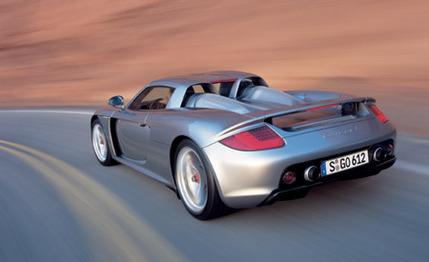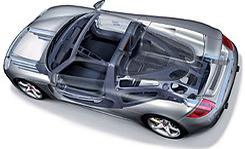
 First Drive Review
First Drive Review
Almost three years ago, Porsche stunned members of the media at the Paris auto show by unveiling the Carrera GT, a mid-engined supercar in the Ferrari Enzo vein that was more exotic than any roadgoing car the company had ever created.
It was based on a Le Mans race car that Porsche had designed and decided not to campaign. At Paris, Porsche CEO Wendelin Wiedeking announced his eagerness to put the Carrera GT into production, but only if there were enough interest to sell the 1000 units needed to justify the investment.
Despite the world economic downturn since 2000, interest in the Carrera GT has been red-hot among the remaining well-heeled, so Porsche announced at the 2002 Detroit show that it was going to build the Carrera GT. And at the Geneva show this past March, the company revealed the production version of the car.
The GT will be built at the Leipzig factory, where the Cayenne SUV is assembled. Deliveries will begin this fall, and the entire run of no more than 1500 cars should be completed by the end of 2004. The base price is about $410,000. What follows is all the information we have been able to glean about the Carrera GT to this point. If you like what you read, get your order in early, because we suspect Porsche will have little trouble moving these machines.
Interior Styling
In the cockpit, the production car faithfully embodies the main themes of the concept. The biggest change is the substitution of a conventional 911-like five-instrument cluster for the multifunctional liquid-crystal display used in the concept car. "We simply couldn't find a supplier who could deliver an electronic display that met our size and functional requirements," said styling boss Harm Lagaay. Otherwise, the theme of leather and aluminum remains, along with the unusual rising console with its high-mounted shifter.
If there's a bit less aluminum trim than is found in the concept, we can't say we miss it. We certainly don't mind the glossy exposed carbon fiber in place of the aluminum doorsill plates on the concept.
The removable top has two carbon-fiber panels that weigh about five pounds apiece. They are attached with quick-release latches and are stored in the front compartment. Even the seats are made from carbon fiber, each weighing 24 pounds.
Standard equipment includes a custom-fitted five-piece luggage set, an elaborate sound system, and front and side airbags. Air conditioning is optional.
Structure
True to modern race-car practice, the Carrera GT's structure uses a carbon-fiber tub that is lightweight and rigid. The central tub and the front structure are one large unitized molded assembly. A separate rear structure, 
 with three large elements on each side, supports the powertrain and rear suspension. It bolts to the back of the main tub.
with three large elements on each side, supports the powertrain and rear suspension. It bolts to the back of the main tub.
Since the removable roof sections provide no rigidity, the tub has two deep side sills--at least 10 inches high--as well as the rising central console, adding stiffness and strength. To preserve these expensive carbon-fiber components from minor crash damage, crushable bolt-on tubular extensions--fabricated from H400 high-strength steel--protect each end of the car. The bodywork covering this structure is also fabricated from carbon fiber.
Although the GT concept was said to weigh 2756 pounds, the production car has risen to about 3050 pounds. That's still impressively light but not quite as feathery as the million-dollar McLaren F1 (it's less than 2600 pounds), reflecting the Carrera's larger volume and lower cost.
Suspension
Unequal-length control arms are used in the suspension at both ends of the car. These arms are all forged aluminum, except for the large lower arms in the rear, which are constructed from high-strength steel. Additional toe-control links keep the rear wheels pointing in the intended direction, and a power-assisted rack-and-pinion mechanism controls the front wheels.
In the fashion of modern race cars, the suspension motions are controlled by coil-over gas-pressurized shocks mounted horizontally on the structure via pushrods and rockers. This approach not only reduces unsprung weight but also produces an essentially equal relationship between the movement of the wheels and the compression and extension of the suspension. This results in better control, even during the smallest wheel motions. This remote linkage also couples the suspension to the front and rear anti-roll bars. To avoid even the slightest lost motion, all the links and pivots use racing-style spherical joints, with elaborate seals to protect them from real-world contaminants.`